Is Environment a Strategic Priority of the Leading Energy Companies? Evidence from Mission Statements
Abstract
1. Introduction
2. Materials and Methods
2.1. Research Direction
2.2. Sample
2.3. Analytical Procedures
3. Results
3.1. General Patterns
3.2. Spatio-Temporal Context
3.3. Apparent People–Environment Alternative
3.4. ‘Word Clouds’
4. Discussion
4.1. General Interpretation
4.2. Tentative Conceptualization
4.3. Policy Implications
5. Conclusions
Supplementary Materials
Author Contributions
Funding
Institutional Review Board Statement
Informed Consent Statement
Data Availability Statement
Acknowledgments
Conflicts of Interest
References
- Bukhari, S.A.A.; Hashim, F.; Amran, A. Green Banking: A road map for adoption. Int. J. Ethics Syst. 2020, 36, 371–385. [Google Scholar] [CrossRef]
- Çop, S.; Olorunsola, V.O.; Alola, U.V. Achieving environmental sustainability through green transformational leadership policy: Can green team resilience help? Bus. Strategy Environ. 2021, 30, 671–682. [Google Scholar] [CrossRef]
- Lawler, E.E., III; Worley, C.G. Designing organizations for sustainable effectiveness. Organ. Dyn. 2012, 41, 265–270. [Google Scholar] [CrossRef]
- Lenka, P.; Kar, S. Role of ethical leaders in sustainable business: An aristotelian virtue ethics perspective. Probl. Ekorozw. 2021, 16, 201–207. [Google Scholar]
- Lozano, R. A holistic perspective on corporate sustainability drivers. Corp. Soc. Responsib. Environ. Manag. 2015, 22, 32–44. [Google Scholar] [CrossRef]
- Hamel, G. Moon Shots for management: What great challenges must we tackle to reinvent management and make it more relevant to a volatile world? Harv. Bus. Rev. 2009, 87, 91–98. [Google Scholar]
- Ji, H.; Miao, Z. Corporate social responsibility and collaborative innovation: The role of government support. J. Clean. Prod. 2020, 260, 121028. [Google Scholar] [CrossRef]
- Clerici, A.; Gallanti, M. Energy efficiency: Benefits for companies, a burden for the environment. Energ. Elettr. 2008, 85, 13–21. [Google Scholar]
- Dangelico, R.M.; Pontrandolfo, P. Being ‘Green and Competitive’: The Impact of Environmental Actions and Collaborations on Firm Performance. Bus. Strategy Environ. 2015, 24, 413–430. [Google Scholar] [CrossRef]
- Ezeonu, I. Capital Accumulation, Environmental Pollution, and Public Health Challenges in the Nigerian Petroleum Industry: Lessons on Market Criminology. Perspect. Glob. Dev. Technol. 2020, 19, 181–200. [Google Scholar] [CrossRef]
- Fethi, S.; Rahuma, A. The impact of eco-innovation on CO2 emission reductions: Evidence from selected petroleum companies. Struct. Chang. Econ. Dyn. 2020, 53, 108–115. [Google Scholar] [CrossRef]
- Hashmi, M.A.; Damanhouri, A.; Rana, D. Evaluation of Sustainability Practices in the United States and Large Corporations. J. Bus. Ethics 2015, 127, 673–681. [Google Scholar] [CrossRef]
- Hoffmann, V.H.; Busch, T. Corporate carbon performance indicators: Carbon intensity, dependency, exposure, and risk. J. Ind. Ecol. 2008, 12, 505–520. [Google Scholar] [CrossRef]
- Linn, J.; McCormack, K. The roles of energy markets and environmental regulation in reducing coal-fired plant profits and electricity sector emissions. Rand J. Econ. 2019, 50, 733–767. [Google Scholar] [CrossRef]
- Morrow, D.; Rondinelli, D. Adopting corporate environmental management systems: Motivations and results of ISO 14001 and EMAS certification. Eur. Manag. J. 2002, 20, 159–171. [Google Scholar] [CrossRef]
- Raugei, M.; Kamran, M.; Hutchinson, A. A prospective net energy and environmental life-cycle assessment of the UK electricity grid. Energies 2020, 13, 2207. [Google Scholar] [CrossRef]
- Sánchez–Ortiz, J.; García-Valderrama, T.; Rodríguez-Cornejo, V.; Giner-Manso, Y. The effects of environmental regulation on the efficiency of distribution electricity companies in Spain. Energy Environ. 2020, 31, 3–20. [Google Scholar] [CrossRef]
- Smirnova, N.V.; Rudenko, G.V. Tendencies, problems and prospects of innovative technologies implementation by Russian oil companies. J. Ind. Pollut. Control 2017, 33, 937–943. [Google Scholar]
- Chen, Z.F.; Tao, W. Hybrid Strategy—Interference or Integration? How Corporate Communication Impacts Consumers’ Memory and Company Evaluation. Int. J. Strateg. Commun. 2020, 14, 122–138. [Google Scholar] [CrossRef]
- Popescu, C. Is environmental protection a central issue to the business strategy of high profile companies? Content analysis of website corporate communication. J. Urban Reg. Anal. 2017, 9, 87–99. [Google Scholar]
- Valentine, S.; Hollingworth, D. Communication of Organizational Strategy and Coordinated Decision Making as Catalysts for Enhanced Perceptions of Corporate Ethical Values in a Financial Services Company. Empl. Responsib. Rights J. 2015, 27, 213–229. [Google Scholar] [CrossRef]
- Steensen, E.F. Five types of organizational strategy. Scand. J. Manag. 2014, 30, 266–281. [Google Scholar] [CrossRef]
- Tuppen, C. Devising a coherent company environmental communications strategy. Eur. Environ. 1992, 2, 18–21. [Google Scholar] [CrossRef]
- Tao, W.; Wilson, C. The Impact of Corporate Communication on Company Evaluation: Examining the Message Effects of CSR, Corporate Ability, and Hybrid Strategies. Int. J. Strateg. Commun. 2016, 10, 426–444. [Google Scholar] [CrossRef]
- Pearce, J.A.; David, F. Corporate Mission Statements: The Bottom Line. Acad. Manag. Exec. 1987, 1, 109–116. [Google Scholar] [CrossRef]
- Alegre, I.; Berbegal-Mirabent, J.; Guerrero, A.; Mas-Machuca, M. The real mission of the mission statement: A systematic review of the literature. J. Manag. Organ. 2018, 24, 456–473. [Google Scholar] [CrossRef]
- Desmidt, S.; Prinzie, A.; Decramer, A. Looking for the Value of Mission Statements: A Meta-Analysis of 20 Years of Research. Manag. Decis. 2011, 49, 468–483. [Google Scholar] [CrossRef]
- Baral, N.; Pokharel, M.P. How Sustainability Is Reflected in the S&P 500 Companies’ Strategic Documents. Organ. Environ. 2017, 30, 122–141. [Google Scholar]
- Garnett, S.T.; Lawes, M.J.; James, R.; Bigland, K.; Zander, K.K. Portrayal of sustainability principles in the mission statements and on home pages of the world’s largest organizations. Conserv. Biol. 2016, 30, 297–307. [Google Scholar] [CrossRef]
- Molchanova, T.K.; Yashalova, N.N.; Ruban, D.A. Environmental Concerns of Russian Businesses: Top Company Missions and Climate Change Agenda. Climate 2020, 8, 56. [Google Scholar] [CrossRef]
- Yozgat, U.; Karatas, N. Going Green of Mission and Vision Statements: Ethical, Social, and Environmental Concerns across Organizations. Procedia-Soc. Behav. Sci. 2011, 24, 1359–1366. [Google Scholar] [CrossRef]
- Lenkova, O.V. The peculiarities of mission forming in Russia’s oil and gas companies. World Appl. Sci. J. 2013, 27, 345–348. [Google Scholar]
- Carmon, A.F. Is it necessary to be clear? An examination of strategic ambiguity in family business mission statements. Qual. Res. Rep. Commun. 2013, 14, 87–96. [Google Scholar] [CrossRef]
- King, D.L.; Case, C.J.; Premo, K.M. 2012 mission statements: A ten country global analysis. Acad. Strateg. Manag. J. 2013, 12, 77–94. [Google Scholar]
- Lin, Y.; Ryan, C. From mission statement to airline branding. J. Air Transp. Manag. 2016, 53, 150–160. [Google Scholar] [CrossRef]
- Tenca, E. Remediating corporate communication through the web: The case of about us sections in companies’ global websites. ESP Today 2018, 6, 84–106. [Google Scholar] [CrossRef]
- Verboven, H. Communicating CSR and Business Identity in the Chemical Industry through Mission Slogans. Bus. Commun. Q. 2011, 74, 415–431. [Google Scholar] [CrossRef]
- Atrill, P.; Omran, M.; Pointon, J. Company mission statements and financial performance. Corp. Ownersh. Control 2005, 2, 28–35. [Google Scholar] [CrossRef]
- Bart, C.K.; Baetz, M.C. The relationship between mission statements and firm performance: An exploratory study. J. Manag. Stud. 1998, 35, 823–853. [Google Scholar] [CrossRef]
- Bart, C.K.; Bontis, N.; Taggar, S. A model of the impact of mission statements on firm performance. Manag. Decis. 2001, 39, 19–35. [Google Scholar] [CrossRef]
- Cortés–Sánchez, J.D.; Rivera, L. Mission statements and financial performance in Latin-American firms. Bus. Theory Pract. 2019, 20, 270–283. [Google Scholar] [CrossRef][Green Version]
- Gharleghi, E.; Nikbakht, F.; Bahar, G. A survey of relationship between the characteristics of mission statement and organizational performance. Res. J. Bus. Manag. 2011, 5, 117–124. [Google Scholar] [CrossRef]
- Jovanov Marjanova, T.; Sofijanova, E. Corporate mission statement and business performance: Through the prism of Macedonian companies. Balk. Soc. Sci. Rev. 2014, 3, 179–198. [Google Scholar]
- Mersland, R.; Nyarko, S.A.; Szafarz, A. Do social enterprises walk the talk? Assessing microfinance performances with mission statements. J. Bus. Ventur. Insights 2019, 11, e00117. [Google Scholar] [CrossRef]
- Sheaffer, Z.; Landau, D.; Drori, I. Mission statement and performance: An evidence of “Coming of Age”. Organ. Dev. J. 2008, 26, 49–62. [Google Scholar]
- Bartkus, B.; Glassman, M.; McAfee, B. Do large European, US and Japanese firms use their web sites to communicate their mission? Eur. Manag. J. 2002, 20, 423–429. [Google Scholar] [CrossRef]
- Lee, M.-Y.; Fairhurst, A.; Wesley, S. Corporate social responsibility: A review of the top 100 US retailers. Corp. Reput. Rev. 2009, 12, 140–158. [Google Scholar] [CrossRef]
- Sones, M.; Grantham, S.; Vieira, E.T. Communicating CSR via pharmaceutical company web sites: Evaluating message frameworks for external and internal stakeholders. Corp. Commun. Int. J. 2009, 14, 144–157. [Google Scholar] [CrossRef]
- David, F.R. How companies define their mission. Long Range Plan. 1989, 22, 90–97. [Google Scholar] [CrossRef]
- The Platts. Top 250 Global Energy Company Rankings. Available online: https://www.spglobal.com/platts/top250/rankings (accessed on 15 March 2020).
- Platts. Top 250 Fastest Growing Companies. Available online: https://www.spglobal.com/platts/top250/fastest-growing (accessed on 15 March 2020).
- King, D.L.; Case, C.J.; Premo, K.M. Does company size affect mission statement content? Acad. Strateg. Manag. J. 2014, 13, 21–34. [Google Scholar]
- Weinfurtner, T.; Seidl, M. Towards a spatial perspective: An integrative review of research on organisational space. Scand. J. Manag. 2019, 35, 101009. [Google Scholar] [CrossRef]
- Oberfield, Z.W. Accounting for time: Comparing temporal and atemporal analyses of the business case for diversity management. Public Adm. Rev. 2014, 74, 777–789. [Google Scholar] [CrossRef]
- Delisle, J. Uncovering temporal underpinnings of project management standards. Int. J. Proj. Manag. 2019, 37, 968–978. [Google Scholar] [CrossRef]
- Ellwood, P.; Horner, S. In search of lost time: The temporal construction of innovation management. R D Manag. 2020, 50, 364–379. [Google Scholar] [CrossRef]
- Wrede, M.; Dauth, T. A temporal perspective on the relationship between top management team internationalization and firms’ innovativeness. Manag. Decis. Econ. 2020, 41, 542–561. [Google Scholar] [CrossRef]
- Bartkus, B.; Glassman, M.; McAfee, R.B. A comparison of the quality of European, Japanese and U.S. mission statements: A content analysis. Eur. Manag. J. 2004, 22, 393–401. [Google Scholar] [CrossRef]
- Low, M.P.; Siegel, D. A bibliometric analysis of employee-centred corporate social responsibility research in the 2000s. Soc. Responsib. J. 2019, 16, 691–717. [Google Scholar] [CrossRef]
- Klemm, M.; Sanderson, S.; Luffman, G. Mission statements: Selling corporate values to employees. Long Range Plan. 1991, 24, 73–78. [Google Scholar] [CrossRef]
- Kopaneva, I.M. Left in the Dust: Employee Constructions of Mission and Vision Ownership. Int. J. Bus. Commun. 2019, 56, 122–145. [Google Scholar] [CrossRef]
- Kopaneva, I.; Sias, P.M. Lost in translation: Employee and organizational constructions of mission and vision. Manag. Commun. Q. 2015, 29, 358–384. [Google Scholar] [CrossRef]
- DePaolo, C.A.; Wilkinson, K. Get Your Head into the Clouds: Using Word Clouds for Analyzing Qualitative Assessment Data. TechTrends 2014, 58, 38–44. [Google Scholar] [CrossRef]
- Filatova, O. More Than a Word Cloud. Tesol J. 2016, 7, 438–448. [Google Scholar] [CrossRef]
- Fu, Y.; Xiong, K.; Zhang, Z. Ecosystem services and ecological compensation of world heritage: A literature review. J. Nat. Conserv. 2021, 60, 125968. [Google Scholar] [CrossRef]
- Mulay, P.; Joshi, R.; Chaudhari, A. Distributed Incremental Clustering Algorithms: A Bibliometric and Word-Cloud Review Analysis. Sci. Technol. Libr. 2020, 39, 289–306. [Google Scholar] [CrossRef]
- Ruban, D.A.; Yashalova, N.N. Lost in Missions? Employees as a Top Strategic Priority of the World’s Biggest Banks. J. Risk Financ. Manag. 2021, 14, 46. [Google Scholar] [CrossRef]
- Azad, A.K.; Rasul, M.G.; Islam, R.; Ahmed, S.F. A study on energy and environmental management techniques used in petroleum process industries. In Exergy for a Better Environment and Improved Sustainability 2; Springer: Cham, Switzerland; pp. 219–230.
- Ruka, A.; Rashidirad, M. Exploring the environmental strategy of big energy companies to drive sustainability. Strateg. Chang. 2019, 28, 435–443. [Google Scholar] [CrossRef]
- Prechel, H.; Istvan, A. Disproportionality of Corporations Environmental Pollution in the Electrical Energy Industry. Sociol. Perspect. 2016, 59, 505–527. [Google Scholar] [CrossRef]
- Best, B.; Miller, K.; McAdam, R.; Moffett, S. Mission or margin? Using dynamic capabilities to manage tensions in social purpose organisations’ business model innovation. J. Bus. Res. 2021, 125, 643–657. [Google Scholar] [CrossRef]
- Shevchenko, I.K.; Razvadovskaya, Y.V.; Kaplyuk, E.V.; Rudneva, K.S. Developing indicators for assessing the dynamic capabilities of industrial enterprises. Terra Econ. 2020, 18, 121–139. [Google Scholar] [CrossRef]
- Bey, N.; Hauschild, M.Z.; McAloone, T.C. Drivers and barriers for implementation of environmental strategies in manufacturing companies. Cirp Ann. Manuf. Technol. 2013, 62, 43–46. [Google Scholar] [CrossRef]
- Cater, B.; Cater, T.; Prašnikar, J.; Ivaškovic, I. Environmental strategy and its implementation: What’s in it for companies and does it pay off in a posttransition context? J. East Eur. Manag. Stud. 2018, 23, 55–88. [Google Scholar] [CrossRef]
- Minkov, I. Organizational culture—A key factor for the creation and implementation of the company strategy. Ikon. Izsled. 2009, 18, 91–123. [Google Scholar]
- Sæverud, I.A.; Skjærseth, J.B. Oil companies and climate change: Inconsistencies between strategy formulation and implementation? Glob. Environ. Politics 2017, 7, 42–62. [Google Scholar] [CrossRef]
- Nosachevskiy, K.; Nosachevskaya, E.; Afanasjeva, L. Implementation of National Projects in Russia: Approaches, Organization, Management Control. Vision 2025: Education Excellence and Management of Innovations through Sustainable Economic Competitive Advantage. In Proceedings of the 34th International-Business-Information-Management-Association (IBIMA) Conference, Madrid, Spain, 13–14 November 2019; IBIMA: Madrid, Spain; pp. 150–155. [Google Scholar]
- Potravny, I.M.; Novoselov, A.L.; Gangut, I.B. Formalization of the general model of the green economy at the regional level. Econ. Reg. 2016, 2, 438–450. [Google Scholar]
- Karasmanaki, E.; Galatsidas, S.; Tsantopoulos, G. An investigation of factors affecting the willingness to invest in renewables among environmental students: A logistic regression approach. Sustainability 2019, 11, 5012. [Google Scholar] [CrossRef]
- Zerinou, I.; Karasmanaki, E.; Ioannou, K.; Andrea, V.; Tsantopoulos, G. Energy saving: Views and attitudes among primary school students and their parents. Sustainability 2020, 12, 6206. [Google Scholar] [CrossRef]
- Gómez-Román, C.; Lima, M.L.; Seoane, G.; Alzate, M.; Dono, M.; Sabucedo, J.-M. Testing common knowledge: Are northern europeans and millennials more concerned about the environment? Sustainability 2021, 13, 45. [Google Scholar] [CrossRef]
- Lehnert, M.; Fiedor, D.; Frajer, J.; Hercik, J.; Jurek, M. Czech students and mitigation of global warming: Beliefs and willingness to take action. Environ. Educ. Res. 2020, 26, 864–889. [Google Scholar] [CrossRef]
- Janmaimool, P.; Khajohnmanee, S. Roles of environmental system knowledge in promoting university students’ environmental attitudes and pro-environmental behaviors. Sustainability 2019, 11, 4270. [Google Scholar] [CrossRef]
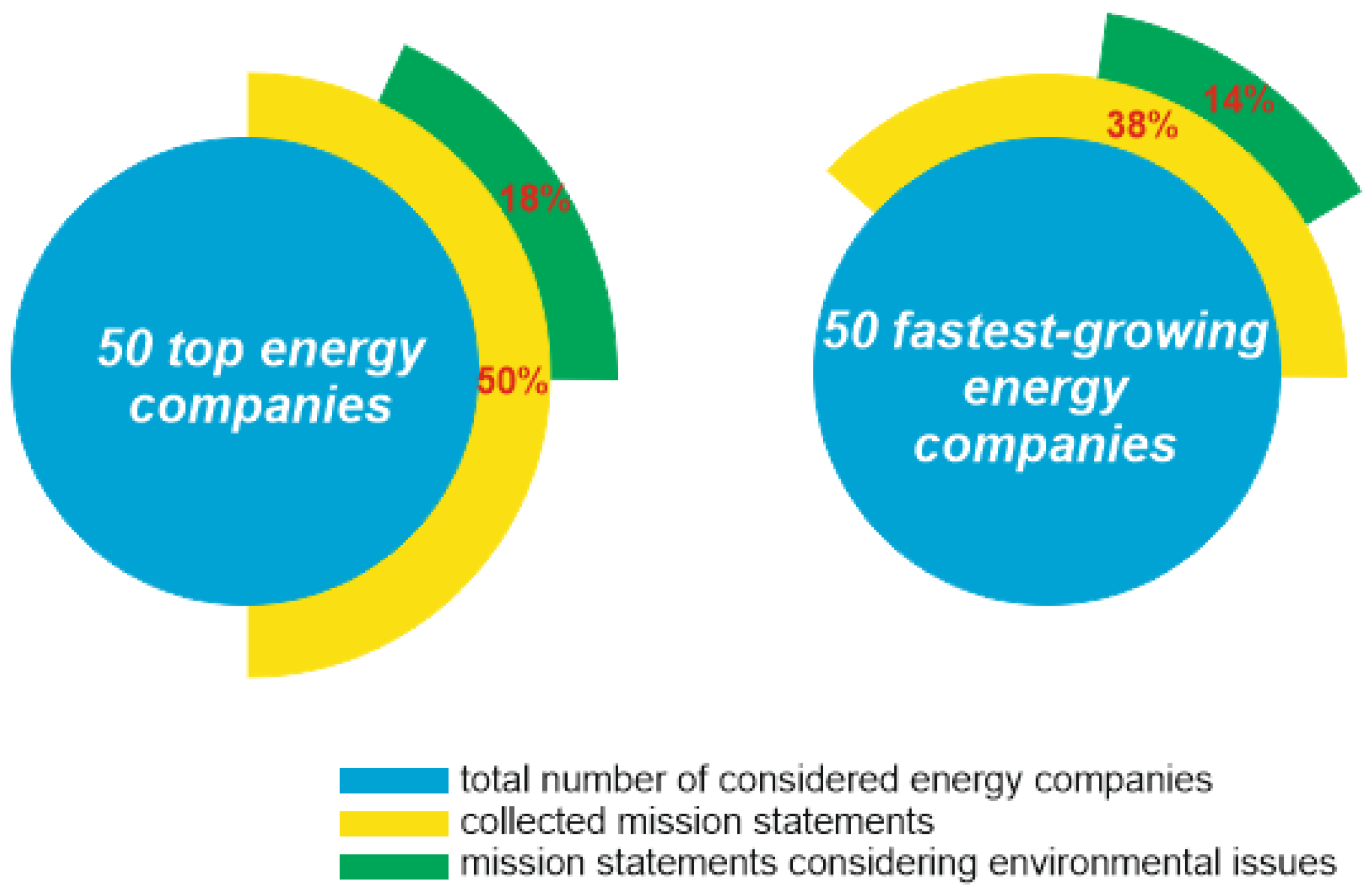
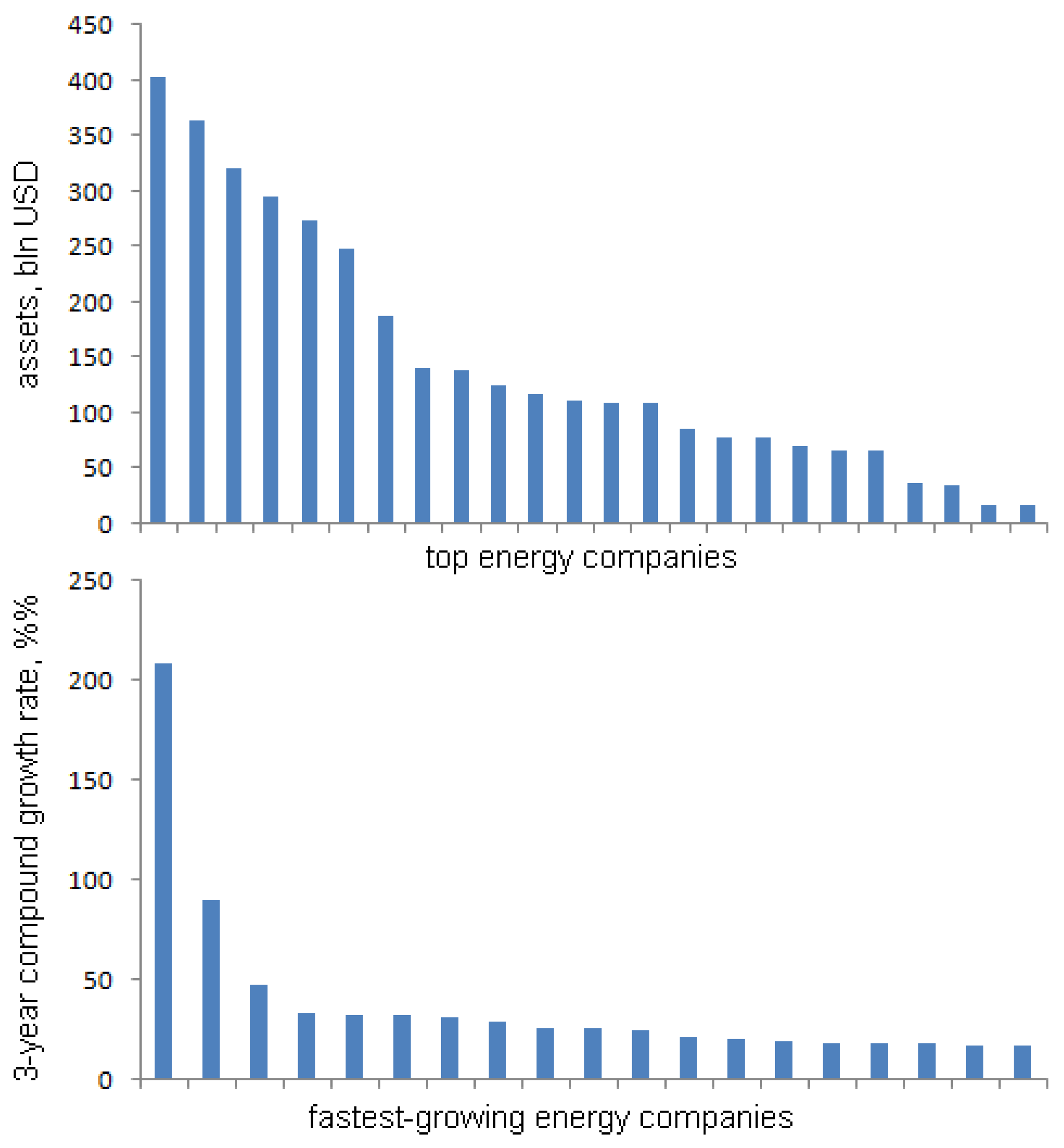
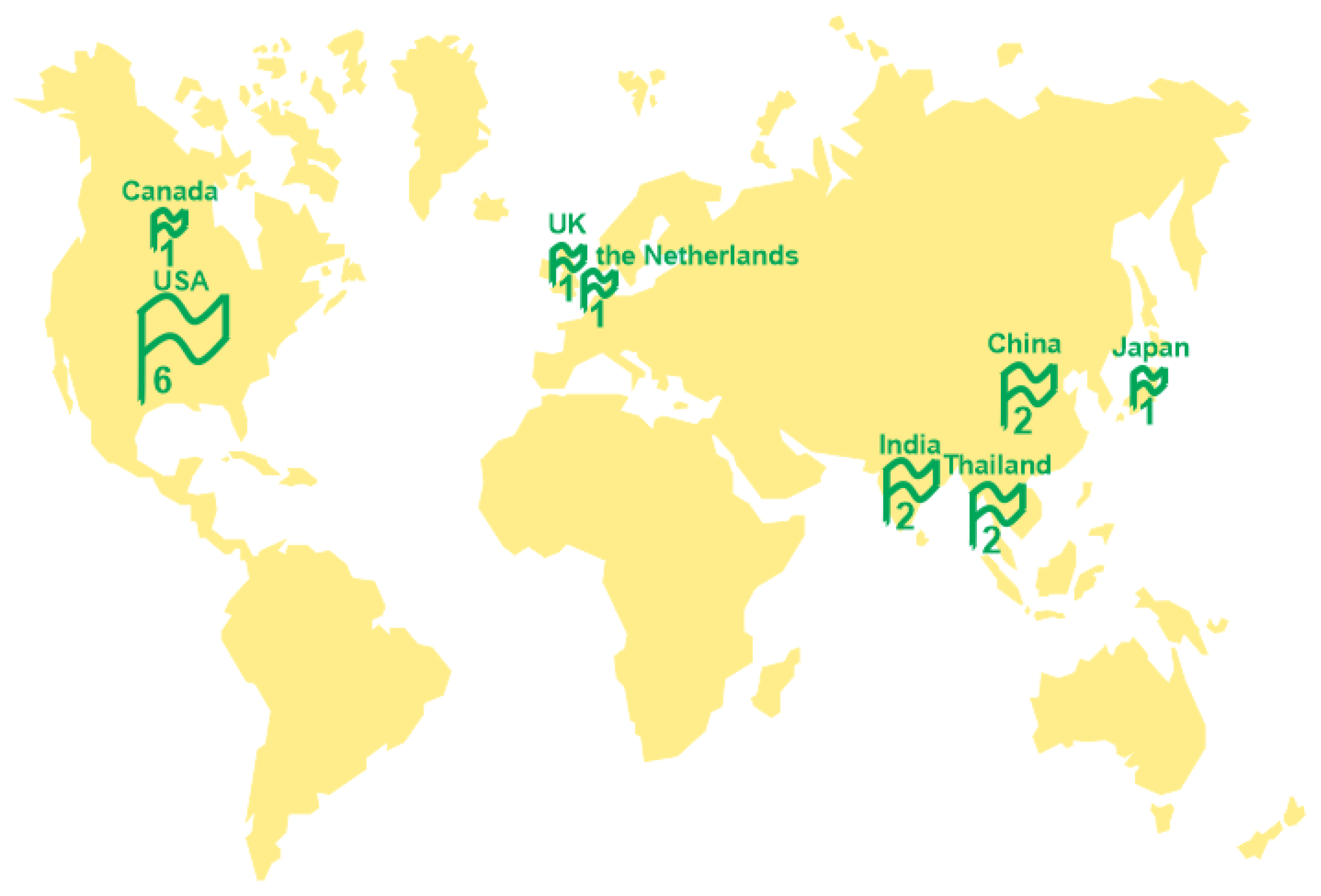
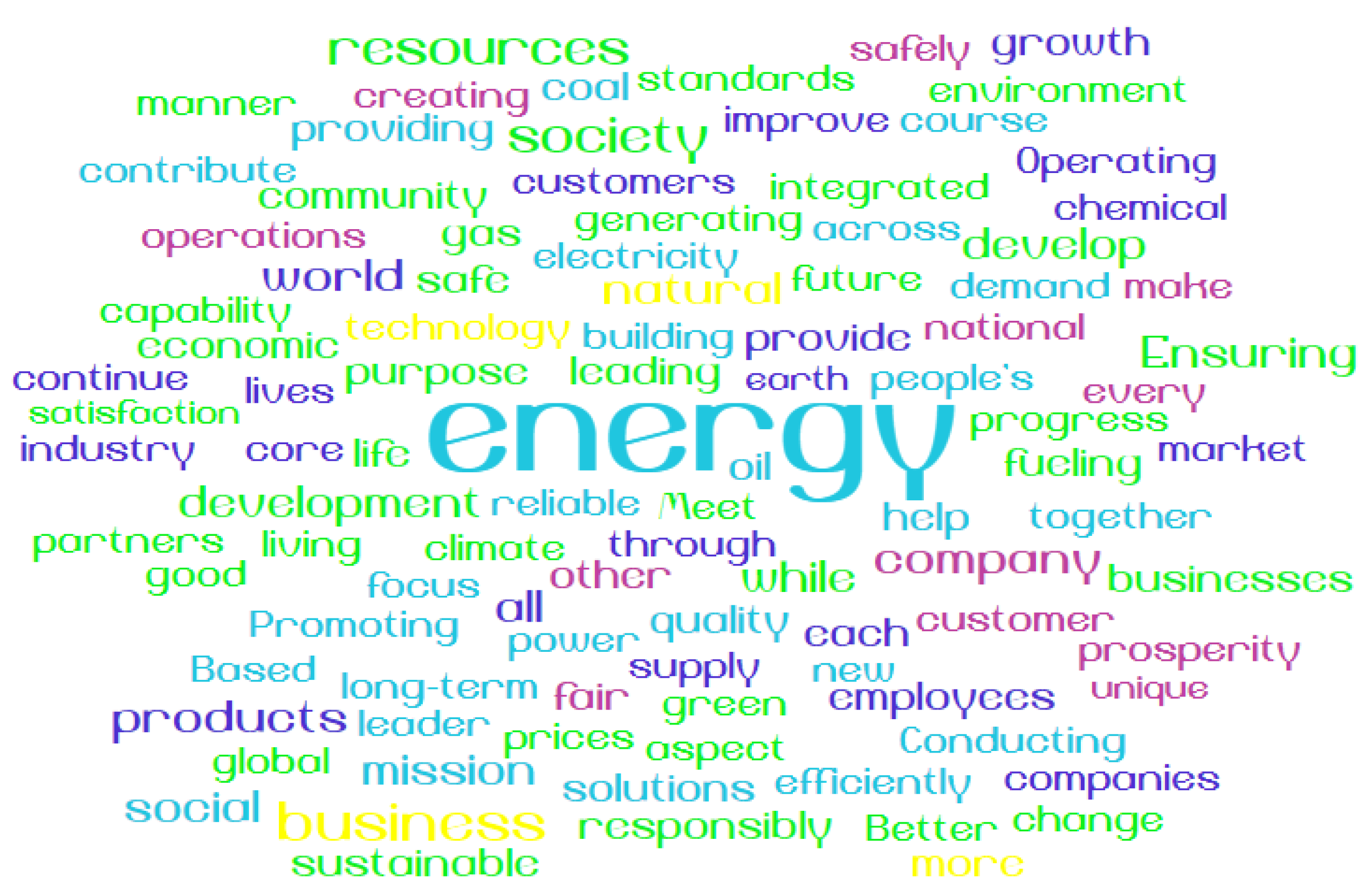

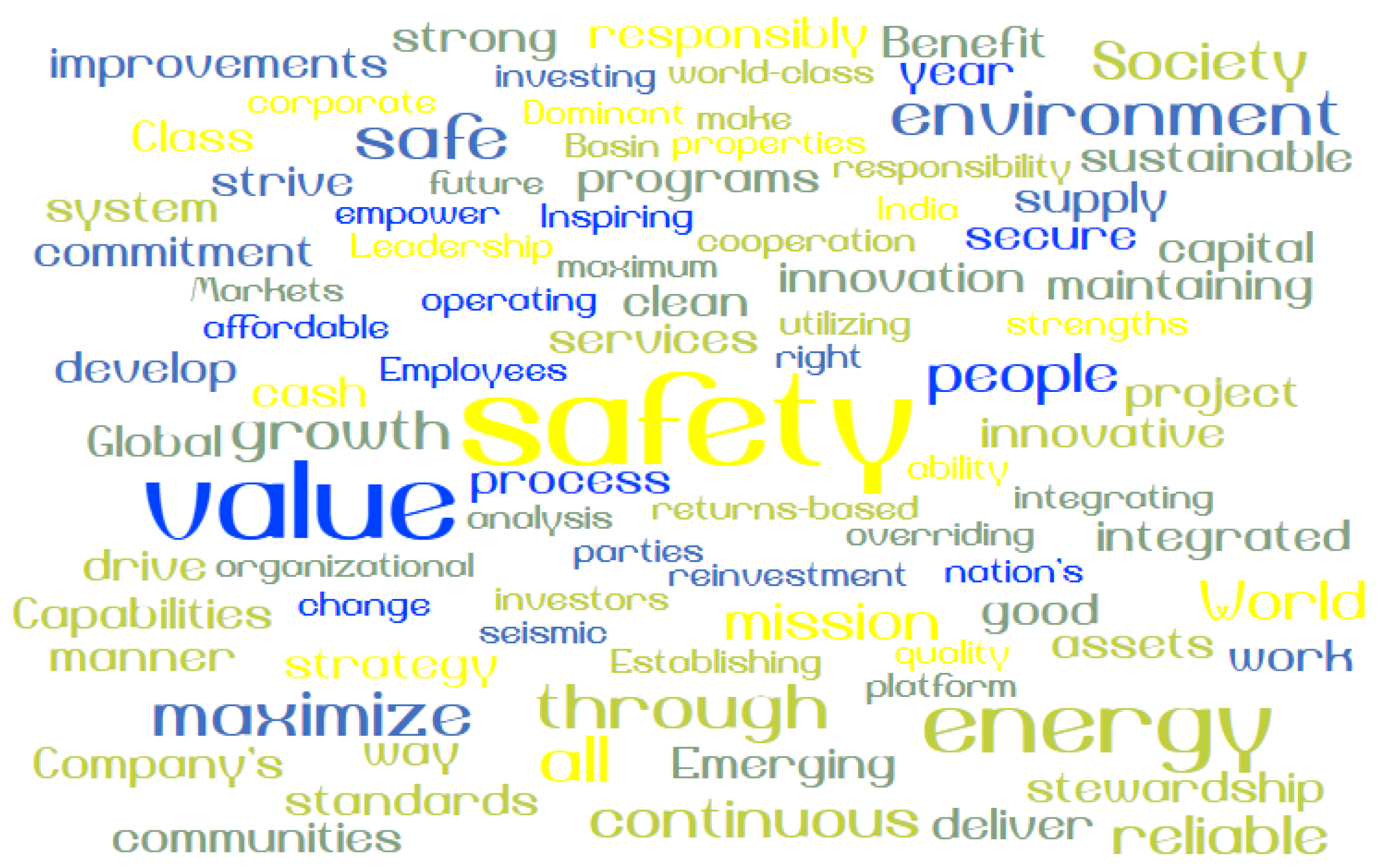
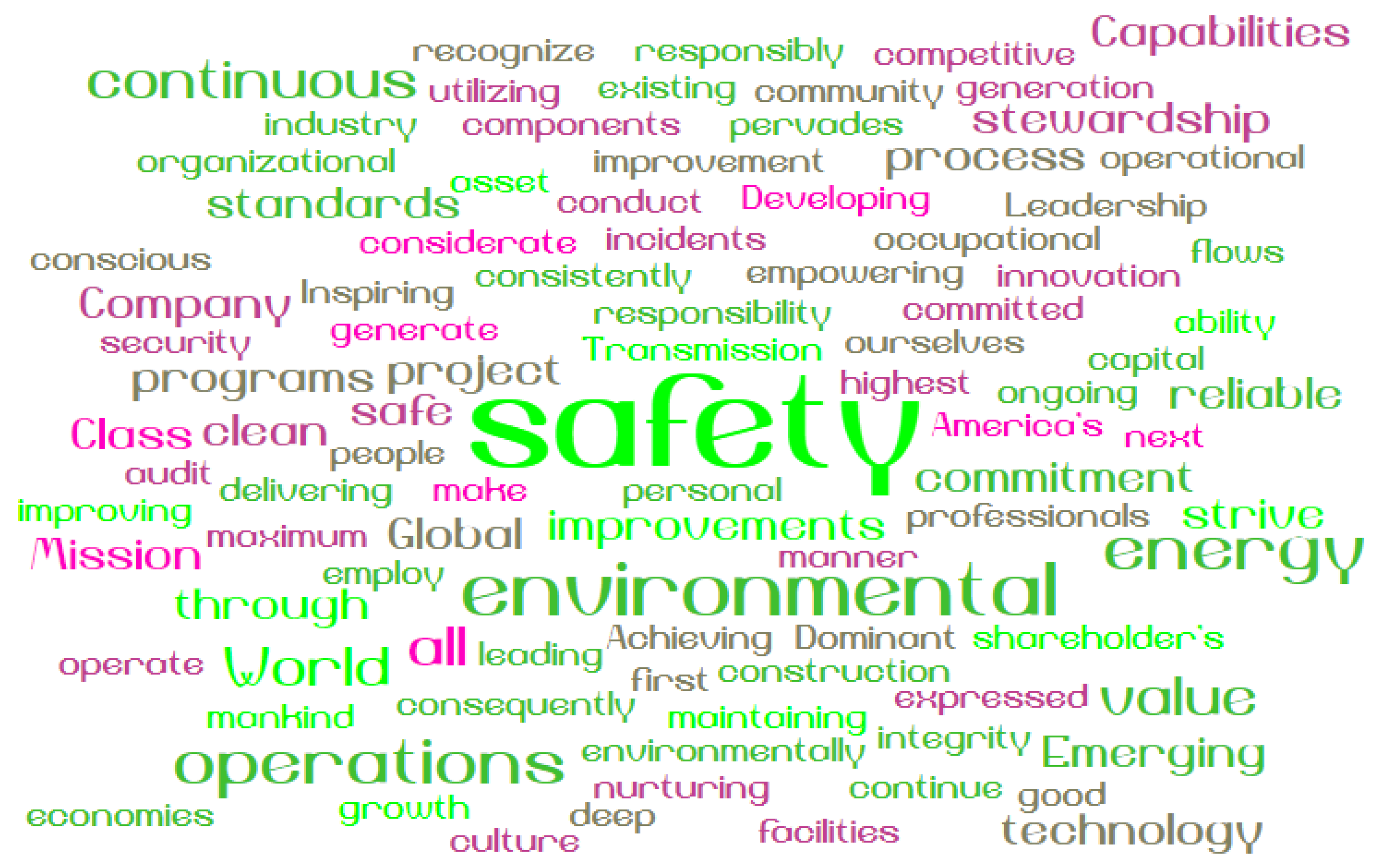
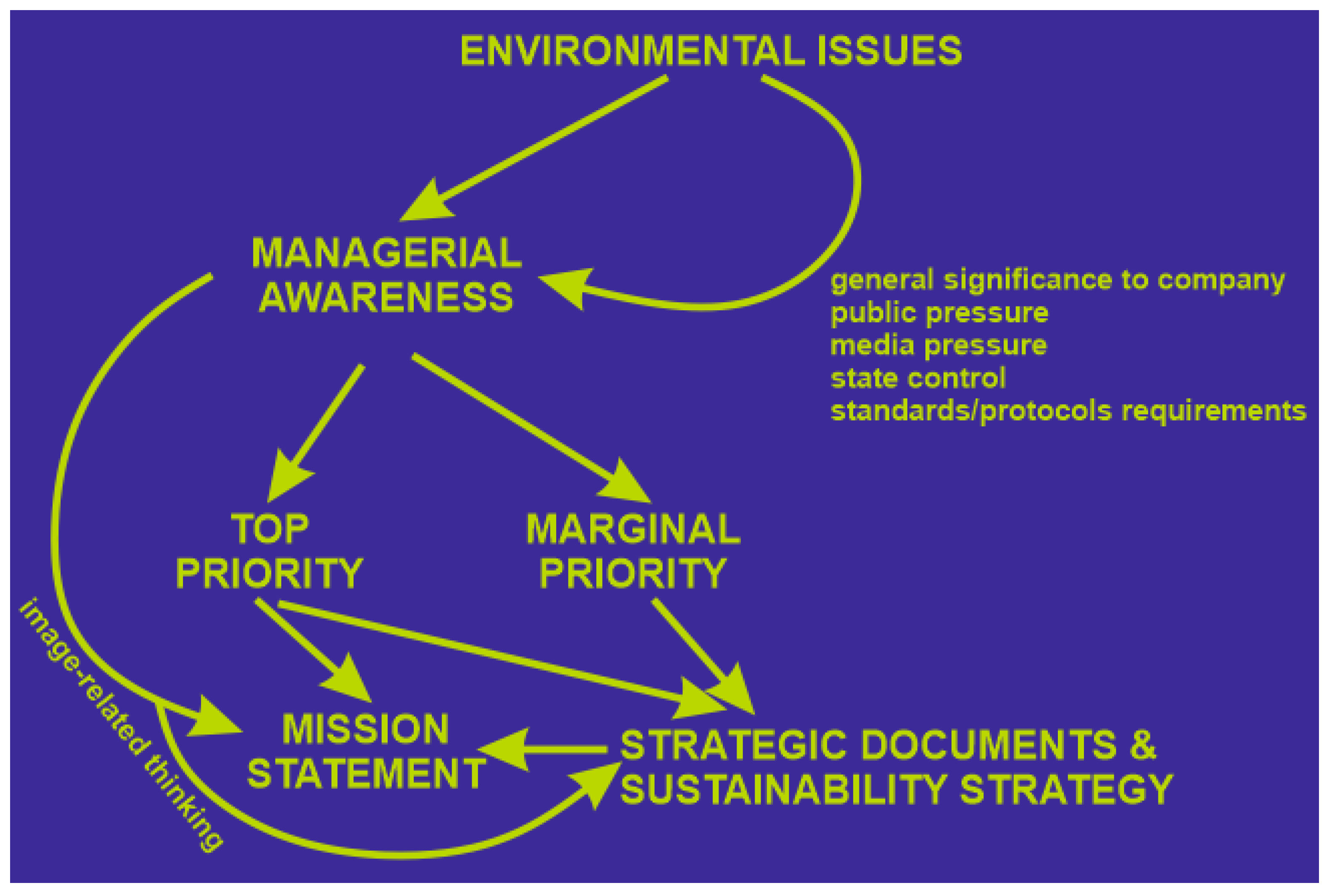
| Companies | Standard Components of Mission Statements | ||||||||
|---|---|---|---|---|---|---|---|---|---|
| CUS | MAR | IMA | PRO | TEC | SGP | PHI | SUN | EMP | |
| Top energy companies | |||||||||
| A | v | v | v | v | v | v | |||
| B | v | v | v | v | |||||
| C | v | v | v | v | |||||
| D | v | v | v | ||||||
| E | v | v | v | v | v | v | v | v | |
| F | v | v | v | ||||||
| G | v | v | v | ||||||
| H | v | v | v | v | v | v | |||
| I | v | v | v | v | |||||
| Fastest-growing energy companies | |||||||||
| J | v | v | v | v | v | v | v | v | v |
| K | v | v | v | v | v | v | |||
| L | v | v | |||||||
| M | v | v | v | v | |||||
| N | v | v | v | v | v | v | v | v | |
| O | v | v | v | v | |||||
| P | v | v | v | v | |||||
| Companies | Environmental Issues | ||||
|---|---|---|---|---|---|
| Care for Nature | Production Ecologization | Ecological Standards | Climate Change | Eco-Responsibility | |
| Top energy companies | |||||
| A | v | ||||
| B | v | ||||
| C | v | v | |||
| D | v | ||||
| E | v | ||||
| F | v | ||||
| G | v | v | v | ||
| H | v | ||||
| I | v | v | |||
| Fastest-growing energy companies | |||||
| J | v | ||||
| K | v | ||||
| L | v | ||||
| M | v | ||||
| N | v | ||||
| O | v | v | |||
| P | v | ||||
| Companies | Space | Time | ||||||
|---|---|---|---|---|---|---|---|---|
| Local | National | Global | Indefinite | Past | Present | Future | Indefinite | |
| Top energy companies | ||||||||
| A | v | v | ||||||
| B | v | v | ||||||
| C | v | v | ||||||
| D | v | v | ||||||
| E | v | v | ||||||
| F | v | v | ||||||
| G | v | v | ||||||
| H | v | v | v | |||||
| I | v | v | ||||||
| Fastest-growing energy companies | ||||||||
| J | v | v | ||||||
| K | v | v | ||||||
| L | v | v | ||||||
| M | v | v | ||||||
| N | v | v | ||||||
| O | v | v | ||||||
| P | v | v | ||||||
| Employees | Society | Environment |
|---|---|---|
| Top energy companies | ||
| - | - | v |
| - | - | - |
| - | - | v |
| - | v | - |
| - | v | v |
| - | v | - |
| - | - | - |
| - | v | v |
| - | - | - |
| - | v | - |
| - | - | - |
| - | v | - |
| v | - | - |
| v | v | v |
| - | - | - |
| - | v | v |
| - | - | - |
| - | v | v |
| - | - | - |
| - | v | - |
| - | - | - |
| - | - | - |
| v | v | - |
| - | v | v |
| - | v | v |
| Fastest-growing energy companies | ||
| - | - | - |
| - | - | - |
| - | v | - |
| v | v | v |
| v | - | - |
| v | - | v |
| v | v | - |
| - | - | - |
| - | v | v |
| - | - | - |
| - | v | - |
| v | v | - |
| - | v | v |
| v | v | - |
| - | v | - |
| - | - | - |
| v | - | v |
| - | v | v |
| v | - | v |
Publisher’s Note: MDPI stays neutral with regard to jurisdictional claims in published maps and institutional affiliations. |
© 2021 by the authors. Licensee MDPI, Basel, Switzerland. This article is an open access article distributed under the terms and conditions of the Creative Commons Attribution (CC BY) license (http://creativecommons.org/licenses/by/4.0/).
Share and Cite
Ruban, D.A.; Yashalova, N.N.; Ermolaev, V.A. Is Environment a Strategic Priority of the Leading Energy Companies? Evidence from Mission Statements. Sustainability 2021, 13, 2192. https://doi.org/10.3390/su13042192
Ruban DA, Yashalova NN, Ermolaev VA. Is Environment a Strategic Priority of the Leading Energy Companies? Evidence from Mission Statements. Sustainability. 2021; 13(4):2192. https://doi.org/10.3390/su13042192
Chicago/Turabian StyleRuban, Dmitry A., Natalia N. Yashalova, and Vladimir A. Ermolaev. 2021. "Is Environment a Strategic Priority of the Leading Energy Companies? Evidence from Mission Statements" Sustainability 13, no. 4: 2192. https://doi.org/10.3390/su13042192
APA StyleRuban, D. A., Yashalova, N. N., & Ermolaev, V. A. (2021). Is Environment a Strategic Priority of the Leading Energy Companies? Evidence from Mission Statements. Sustainability, 13(4), 2192. https://doi.org/10.3390/su13042192







